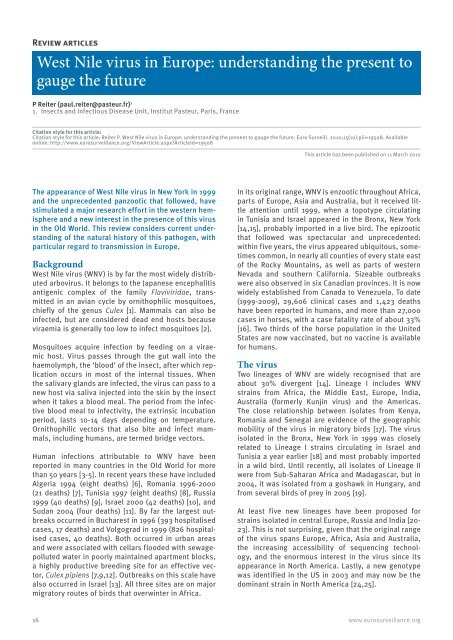Vector-borne diseases - Eurosurveillance
Vector-borne diseases - Eurosurveillance
Vector-borne diseases - Eurosurveillance
Create successful ePaper yourself
Turn your PDF publications into a flip-book with our unique Google optimized e-Paper software.
Review articles<br />
West Nile virus in Europe: understanding the present to<br />
gauge the future<br />
P Reiter (paul.reiter@pasteur.fr) 1<br />
1. Insects and Infectious Disease Unit, Institut Pasteur, Paris, France<br />
Citation style for this article:<br />
Citation style for this article: Reiter P. West Nile virus in Europe: understanding the present to gauge the future. Euro Surveill. 2010;15(10):pii=19508. Available<br />
online: http://www.eurosurveillance.org/ViewArticle.aspx?ArticleId=19508<br />
The appearance of West Nile virus in New York in 1999<br />
and the unprecedented panzootic that followed, have<br />
stimulated a major research effort in the western hemisphere<br />
and a new interest in the presence of this virus<br />
in the Old World. This review considers current understanding<br />
of the natural history of this pathogen, with<br />
particular regard to transmission in Europe.<br />
Background<br />
West Nile virus (WNV) is by far the most widely distributed<br />
arbovirus. It belongs to the Japanese encephalitis<br />
antigenic complex of the family Flaviviridae, transmitted<br />
in an avian cycle by ornithophilic mosquitoes,<br />
chiefly of the genus Culex [1]. Mammals can also be<br />
infected, but are considered dead end hosts because<br />
viraemia is generally too low to infect mosquitoes [2].<br />
Mosquitoes acquire infection by feeding on a viraemic<br />
host. Virus passes through the gut wall into the<br />
haemolymph, the ‘blood’ of the insect, after which replication<br />
occurs in most of the internal tissues. When<br />
the salivary glands are infected, the virus can pass to a<br />
new host via saliva injected into the skin by the insect<br />
when it takes a blood meal. The period from the infective<br />
blood meal to infectivity, the extrinsic incubation<br />
period, lasts 10-14 days depending on temperature.<br />
Ornithophilic vectors that also bite and infect mammals,<br />
including humans, are termed bridge vectors.<br />
Human infections attributable to WNV have been<br />
reported in many countries in the Old World for more<br />
than 50 years [3-5]. In recent years these have included<br />
Algeria 1994 (eight deaths) [6], Romania 1996-2000<br />
(21 deaths) [7], Tunisia 1997 (eight deaths) [8], Russia<br />
1999 (40 deaths) [9], Israel 2000 (42 deaths) [10], and<br />
Sudan 2004 (four deaths) [11]. By far the largest outbreaks<br />
occurred in Bucharest in 1996 (393 hospitalised<br />
cases, 17 deaths) and Volgograd in 1999 (826 hospitalised<br />
cases, 40 deaths). Both occurred in urban areas<br />
and were associated with cellars flooded with sewagepolluted<br />
water in poorly maintained apartment blocks,<br />
a highly productive breeding site for an effective vector,<br />
Culex pipiens [7,9,12]. Outbreaks on this scale have<br />
also occurred in Israel [13]. All three sites are on major<br />
migratory routes of birds that overwinter in Africa.<br />
This article has been published on 11 March 2010<br />
In its original range, WNV is enzootic throughout Africa,<br />
parts of Europe, Asia and Australia, but it received little<br />
attention until 1999, when a topotype circulating<br />
in Tunisia and Israel appeared in the Bronx, New York<br />
[14,15], probably imported in a live bird. The epizootic<br />
that followed was spectacular and unprecedented:<br />
within five years, the virus appeared ubiquitous, sometimes<br />
common, in nearly all counties of every state east<br />
of the Rocky Mountains, as well as parts of western<br />
Nevada and southern California. Sizeable outbreaks<br />
were also observed in six Canadian provinces. It is now<br />
widely established from Canada to Venezuela. To date<br />
(1999-2009), 29,606 clinical cases and 1,423 deaths<br />
have been reported in humans, and more than 27,000<br />
cases in horses, with a case fatality rate of about 33%<br />
[16]. Two thirds of the horse population in the United<br />
States are now vaccinated, but no vaccine is available<br />
for humans.<br />
The virus<br />
Two lineages of WNV are widely recognised that are<br />
about 30% divergent [14]. Lineage I includes WNV<br />
strains from Africa, the Middle East, Europe, India,<br />
Australia (formerly Kunjin virus) and the Americas.<br />
The close relationship between isolates from Kenya,<br />
Romania and Senegal are evidence of the geographic<br />
mobility of the virus in migratory birds [17]. The virus<br />
isolated in the Bronx, New York in 1999 was closely<br />
related to Lineage I strains circulating in Israel and<br />
Tunisia a year earlier [18] and most probably imported<br />
in a wild bird. Until recently, all isolates of Lineage II<br />
were from Sub-Saharan Africa and Madagascar, but in<br />
2004, it was isolated from a goshawk in Hungary, and<br />
from several birds of prey in 2005 [19].<br />
At least five new lineages have been proposed for<br />
strains isolated in central Europe, Russia and India [20-<br />
23]. This is not surprising, given that the original range<br />
of the virus spans Europe, Africa, Asia and Australia,<br />
the increasing accessibility of sequencing technology,<br />
and the enormous interest in the virus since its<br />
appearance in North America. Lastly, a new genotype<br />
was identified in the US in 2003 and may now be the<br />
dominant strain in North America [24,25].<br />
16 www.eurosurveillance.org

















